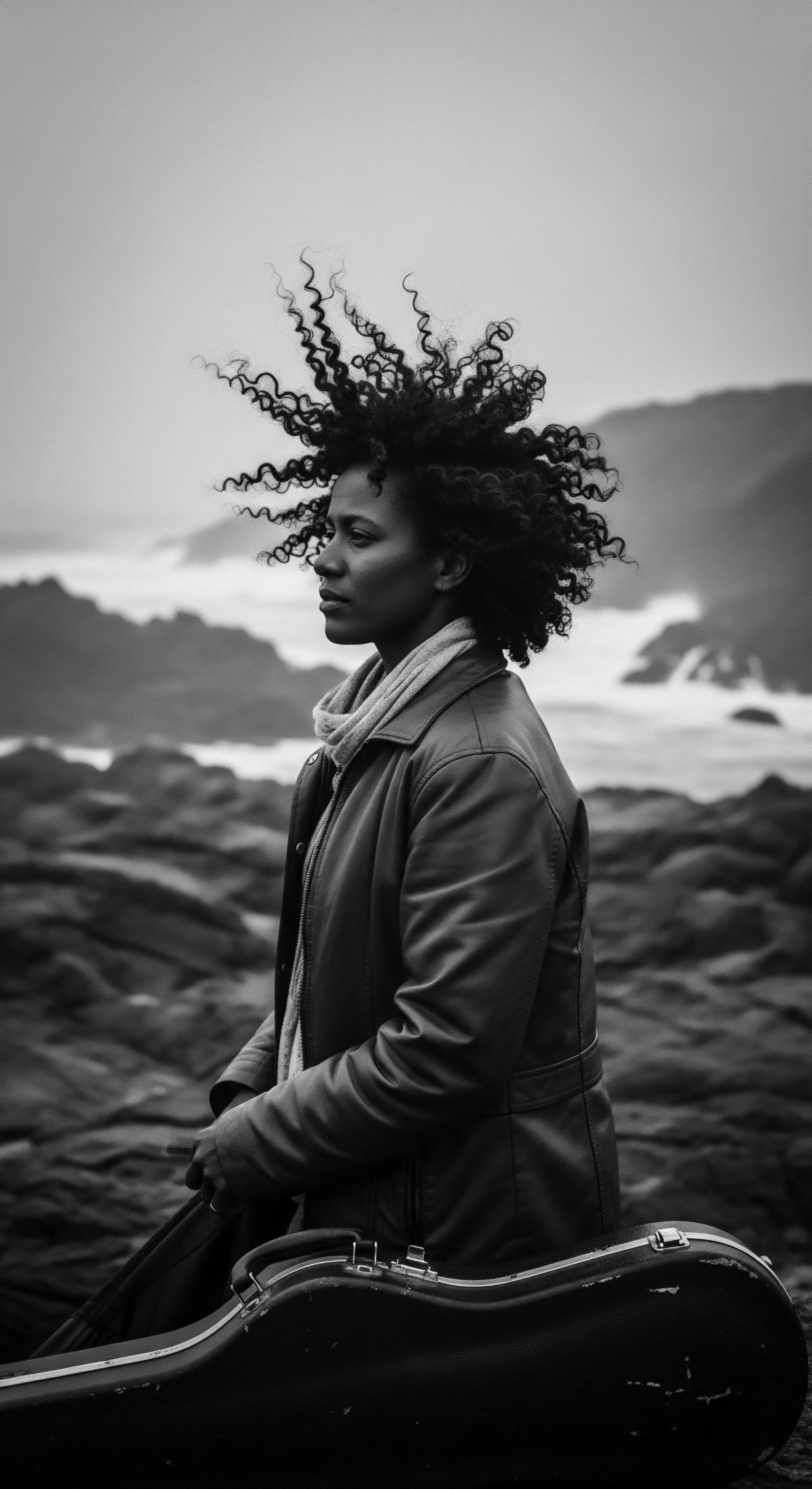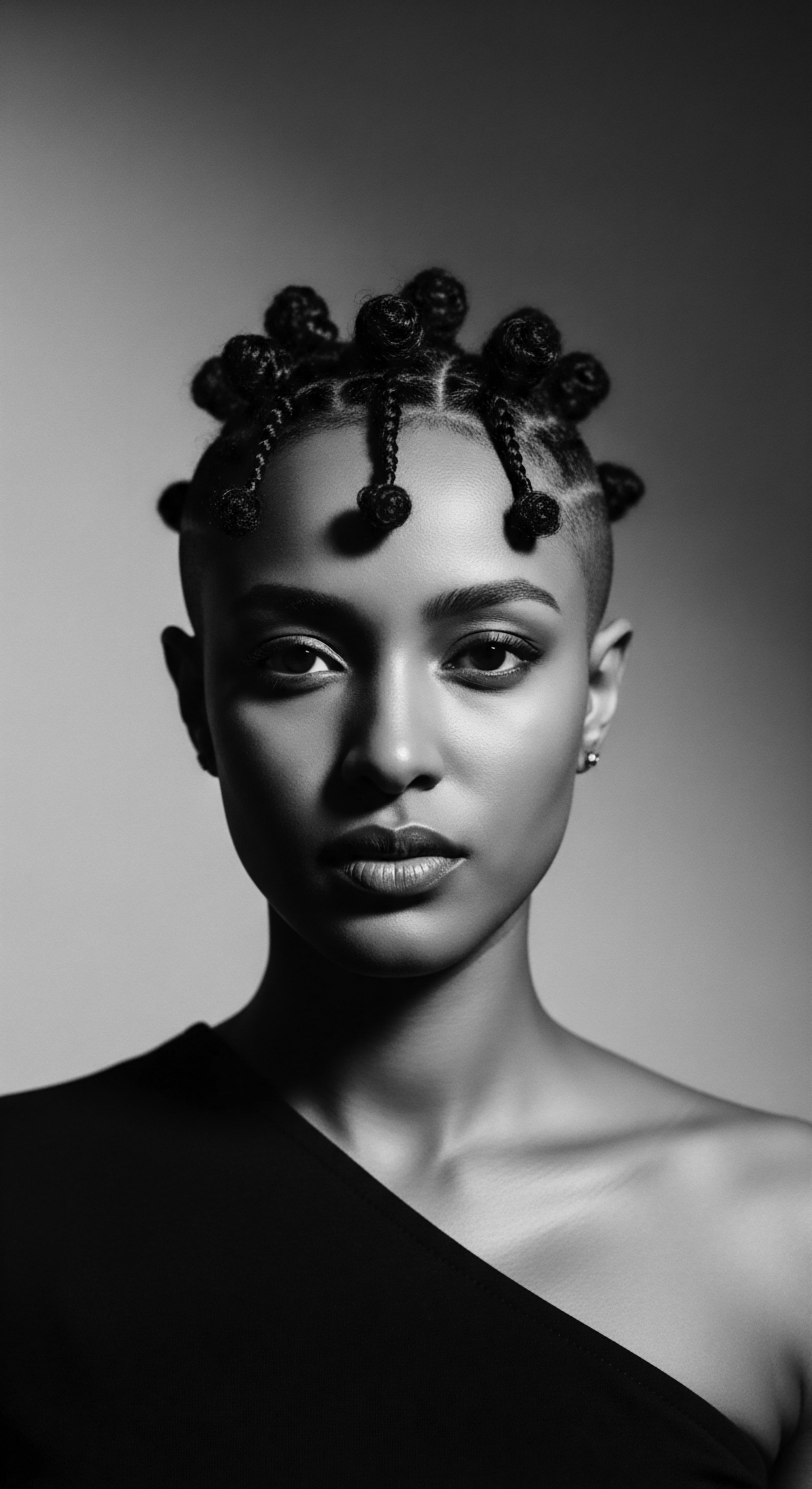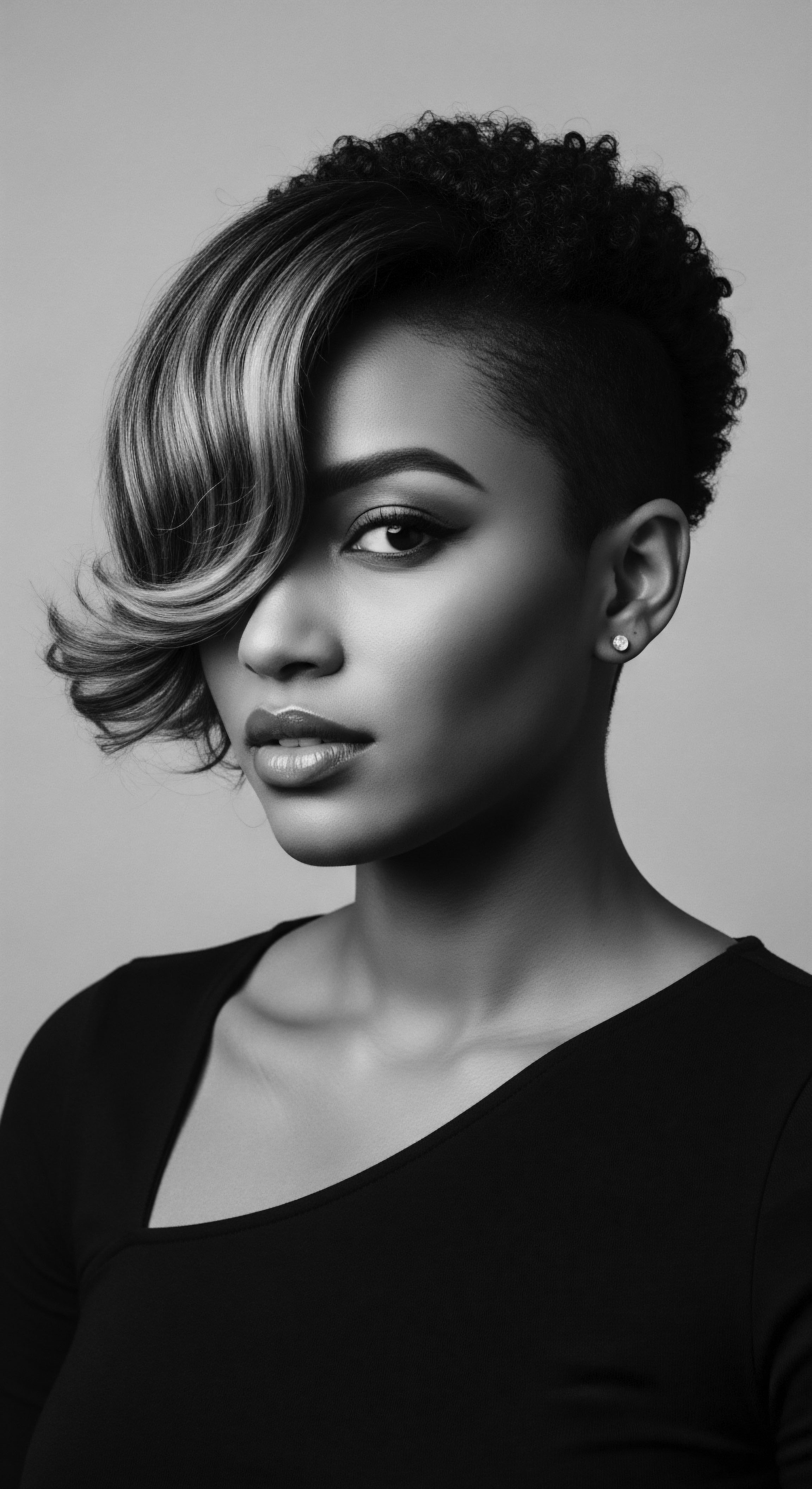
Roots
To journey into the deeper significance of headwraps, one must first listen to the very strands that spring forth from the scalp, a testament to an ancestral narrative whispered through generations. Our textured hair, in its myriad coils and springs, represents far more than a biological wonder; it is a living archive, a cellular memory of adaptation and belonging. This intrinsic connection means that any adornment, particularly the venerable headwrap, becomes an extension of this deeply rooted heritage. The story of headwraps intertwines with the biological blueprint of textured hair, illustrating a dialogue between human ingenuity and nature’s design, shaped by millennia of communal existence.

What are the Inherent Characteristics of Textured Hair?
Textured hair, known scientifically as Ulotrichy, exhibits a distinctive elliptical cross-section and a unique helical growth pattern, differing significantly from straight or wavy hair types. This coiled structure, an evolutionary adaptation primarily seen across African populations, offered critical protection from intense ultraviolet radiation and helped regulate scalp temperature in diverse climates. The very nature of these curls creates natural air pockets, contributing to temperature regulation and defense against environmental elements. This intrinsic characteristic meant hair was not merely an aesthetic feature but a functional shield, fostering practices that acknowledged its protective qualities.
Textured hair, a biological adaptation, served as a natural shield against the sun and helped regulate scalp temperature for early human ancestors.
In pre-colonial African societies, hair was a profound visual language. Hairstyles conveyed intricate messages about an individual’s identity, social standing, marital status, age, and even tribal affiliation. Elaborate coiffures, often involving intricate braiding, twisting, and adornment with beads, shells, or precious metals, reflected a person’s place within the community and their spiritual connection. These styles were not casual choices; they were carefully maintained statements of self and collective identity.
The act of grooming was often communal, strengthening familial and societal bonds. Within such contexts, headwraps often complemented or completed these elaborate styles, serving as a layer of meaning that could signify particular ceremonies, religious devotion, or simply the daily preservation of a meticulously crafted coiffure.

How Did Early Head Coverings Serve Varied Purposes?
The earliest forms of head coverings, including what we now recognize as headwraps, emerged from practical needs as well as cultural symbolism. In ancient African civilizations, headwraps protected against the harsh sun, dust, and wind, particularly in arid regions. Beyond this practical utility, they also held spiritual and ceremonial importance. For instance, hieroglyphic evidence suggests ancient Egyptian royalty wore various head coverings and wigs with specific meanings.
In West Africa, archaeological findings hint at headwrap traditions dating back to the Kingdom of Ghana, where locally woven textiles adorned the head. These early wraps were not merely utilitarian; they were also a display of elegance and sophistication, often worn during significant events. Different African cultures developed their own terms and styles for head coverings:
- Gele ❉ A term used by the Yoruba people of Nigeria for their elaborately folded headwraps, often signifying wealth, status, or special occasions.
- Duku ❉ Employed in Ghana and Malawi, referring to a headscarf that holds various social and cultural meanings.
- Doek ❉ Popular in South Africa and Namibia, a word derived from Afrikaans, often signaling cultural pride and womanhood.
The evolution of headwraps reveals how a simple piece of fabric can encapsulate deep cultural understanding and societal structures. Before the transatlantic slave trade, head coverings in Africa were rarely used to obscure hair. Indeed, unstyled or unkempt hair was seldom seen, as hair was an expression of self and community, a crowning glory meant to be celebrated. This profound cultural connection to hair and its adornments, including headwraps, would later face dramatic shifts under the brutal realities of enslavement.

Ritual
The forced journey across the Atlantic marked a brutal disruption for African peoples, yet within this crucible of dehumanization, the headwrap transformed from a symbol of status and beauty into a powerful tool of defiance and enduring heritage. Once a matter of personal expression and communal identity in ancestral lands, head coverings took on layered, complex meanings under the oppressive conditions of slavery. Enslaved women, stripped of many aspects of their cultural identity, were often compelled to wear head coverings, sometimes for perceived hygiene or as a mark of subservience. Yet, this very imposition became a canvas for silent, persistent resistance.

How Did Headwraps Become Instruments of Subtle Protest?
A particularly stark example of this transformation occurred in 18th-century Louisiana with the implementation of the Tignon Laws. Enacted in 1786 by Spanish colonial governor Esteban Rodriguez Miró, these laws mandated that free women of color cover their hair with a headwrap, or “tignon,” in public. The stated purpose was to curb their perceived extravagance and to visually distinguish them from white women, thereby reinforcing social hierarchies and diminishing their allure to white men. Women of African descent, many of whom had achieved a degree of economic independence and adorned their hair with elaborate styles and jewels, were seen as a threat to the established social order.
In a powerful act of defiance, Black women in colonial Louisiana transformed the oppressive Tignon Laws into opportunities for artistic and cultural expression through elaborate headwraps.
However, in a spectacular act of sartorial insurgency, these women subverted the intent of the law. Instead of accepting the tignon as a badge of inferiority, they adorned their headwraps with luxurious fabrics, ribbons, feathers, and jewels, styling them with remarkable artistry and flair. This act of defiance made the tignon a vibrant symbol of their creativity, individuality, and unbroken spirit.
It became a silent, yet visually powerful, declaration of their cultural identity and a rejection of imposed subjugation. This historical example reveals how a seemingly restrictive garment was reappropriated, turning an instrument of oppression into a statement of autonomy and pride (Byrd & Tharps, 2014).
The resistance of enslaved women extended beyond direct defiance. Headwraps served as a means of non-verbal communication amongst themselves, conveying coded messages that remained hidden from their enslavers. In places like Suriname in Central America, the folds and ties of headscarves were used to send signals, creating a silent network of communication amidst profound oppression.
This ingenuity highlights the deep human need for connection and resistance, even when overt expressions were impossible. Headwraps became a canvas for secret languages, connecting people through shared knowledge and resilience.

How Did Headwraps Signify Identity Shifts and Self-Affirmation?
Even after the abolition of slavery in 1865, the headwrap continued to evolve its symbolism in the African American experience. For a period, it became associated with servitude and domesticity, reinforced by stereotypical imagery like the “mammy” figure. Yet, within homes, particularly for textured hair, headwraps persisted as a practical and protective tool for preserving hairstyles and maintaining hair health overnight. The intimate act of wrapping hair at night, often with silk or satin fabrics to prevent dryness and breakage, became a private ritual of self-care, a quiet assertion of ownership over one’s own body and heritage.
The Civil Rights Movement of the 1960s and 70s brought about a significant resurgence in the public wearing of headwraps. As part of the wider Black Power and natural hair movements, headwraps became powerful symbols of Afrocentric pride, a public rejection of Eurocentric beauty standards, and an affirmation of Black identity. Celebrated figures like Nina Simone and later artists such as Erykah Badu and Lauryn Hill popularized the headwrap, turning it into a bold statement of cultural roots and empowerment.
It represented solidarity and a shared connection to African heritage, a visual proclamation that “Black is beautiful”. This period solidified the headwrap’s place as a badge of honor, representing the ongoing fight for equality and justice.
| Historical Period Pre-Colonial Africa |
| Primary Significance for Textured Hair Heritage Identity, status, spirituality, practical protection from elements, ceremonial adornment. |
| Historical Period Slavery/Colonial Era (e.g. Tignon Laws) |
| Primary Significance for Textured Hair Heritage Forced marker of subservience, transformed into symbol of defiance, resistance, coded communication, and cultural preservation. |
| Historical Period Post-Slavery to Early 20th Century |
| Primary Significance for Textured Hair Heritage Lingering association with servitude publicly; private use for hair protection and personal care. |
| Historical Period Civil Rights & Black Power Movement |
| Primary Significance for Textured Hair Heritage Reclamation as a symbol of Black pride, cultural heritage, political statement, rejection of Eurocentric beauty standards. |
| Historical Period Contemporary Era |
| Primary Significance for Textured Hair Heritage Fashion statement, spiritual expression, protective styling, continued connection to ancestral roots, celebration of diverse heritage. |
| Historical Period The headwrap's meaning for textured hair communities has consistently shifted, always reflecting a deep connection to heritage and evolving societal contexts. |

Relay
The headwrap’s connection to heritage extends deeply into holistic care practices, embodying ancestral wisdom for the unique needs of textured hair. This is not merely about covering hair; it involves a sophisticated understanding of preservation, nourishment, and spiritual well-being passed down through oral tradition and lived experience. The rhythms of care, from daily routines to nighttime rituals, are inextricably linked to the ways headwraps shield and honor the hair.

How do Headwraps Align with Ancestral Hair Care Practices?
Across Africa, communities have long understood the inherent requirements of textured hair, developing practices that prioritized moisture retention, strength, and protection. Traditional ingredients, often sourced locally, formed the basis of these regimens. For instance, in Chad, the Chebe Powder Ritual stands as a testament to ancestral ingenuity. This practice involves applying a paste made from roasted and crushed Chebe seeds, along with cherry seeds and cloves, to the hair strands.
This ritual, passed down through generations, aims to promote hair length and luster by retaining moisture and reducing breakage, proving that lengthy hair is a result of consistent, intentional care, not simply a miracle. This traditional approach highlights how headwraps, in their capacity to hold in moisture and protect treated hair, become an integral part of such restorative regimens.
The physical properties of textured hair, with its tightly coiled structure, make it prone to dryness and breakage if not properly cared for. Ancestral practices, often accompanied by head coverings, sought to mitigate these challenges.
Consider some traditional ingredients employed in African hair care, many of which would be complemented by headwraps for deeper conditioning or protection:
- Shea Butter ❉ Widely used in West Africa, this natural butter provides intense moisture and a protective barrier against environmental damage.
- Marula Oil ❉ Sourced in Southern Africa, prized for its nourishing and rejuvenating properties, contributing to hair health.
- Rooibos Tea ❉ Also from South Africa, used for its antioxidant benefits and soothing qualities in hair rinses.
These ingredients, often applied as part of time-consuming rituals, benefit immensely from the environment created by a headwrap, which helps to seal in moisture and allow the natural properties to work effectively.

What is the Role of Nighttime Rituals in Hair Preservation?
The “Nighttime Sanctuary” for textured hair, often facilitated by headwraps, is a tradition rooted in centuries of practical wisdom and self-preservation. Resting hair, particularly coiled hair, directly on absorbent materials like cotton pillowcases can strip it of moisture and lead to friction, causing tangles and breakage. Silk or satin-lined headwraps and bonnets address this vulnerability, providing a smooth surface that reduces friction and helps retain the hair’s natural oils and applied products. This seemingly simple act is a nightly reaffirmation of heritage, a continuation of practices designed to safeguard hair health.
Headwraps, therefore, serve a dual purpose for textured hair ❉ they function as a practical tool for daily protection against environmental stressors (like sun and dust) and as a crucial element in a holistic care regimen aimed at moisture retention and breakage prevention. This protection is a continuation of ancestral wisdom, where hair was understood to need careful preservation to thrive.
| Aspect Purpose |
| Traditional Approach (Heritage-Based) Physical barrier against elements, spiritual protection, cultural communication. |
| Modern Complement (Science-Informed) Reduced friction, moisture retention, preservation of styled hair, scalp health. |
| Aspect Materials |
| Traditional Approach (Heritage-Based) Locally woven textiles (cotton, silk), natural dyes, adorned with natural elements. |
| Modern Complement (Science-Informed) Silk or satin fabrics, microfiber, specialized breathable materials. |
| Aspect Application |
| Traditional Approach (Heritage-Based) Intricate wrapping techniques often signifying social codes, community rituals. |
| Modern Complement (Science-Informed) Various tying styles for fashion and function, often worn over hair products. |
| Aspect Underlying Principle |
| Traditional Approach (Heritage-Based) Hair as a living entity, a connection to ancestors and spiritual world. |
| Modern Complement (Science-Informed) Understanding of cuticle layers, moisture balance, protein structures for hair integrity. |
| Aspect The enduring utility of headwraps for textured hair bridges ancient practices with contemporary understanding, preserving health and heritage. |
Beyond the physical, headwraps hold significant spiritual and cultural weight. In traditional African religions, head coverings are often worn as a religious aesthetic and a symbol of faith. For instance, new initiates in various traditional African faiths are often identified by wearing white from head to toe, including a headscarf that must be worn at all times. Sangomas, South African healers, frequently cover their heads, linking the practice to spiritual observance.
This spiritual connection highlights that hair, particularly the crown of the head, is often viewed as a conduit for spiritual energy and a sacred part of the self. A headwrap, then, is not merely fabric; it is a spiritual shield, a sign of reverence, and a deep connection to ancestral beliefs. This makes the act of wearing a headwrap a profound personal and communal ritual, a continuous affirmation of identity and spiritual lineage.

Reflection
The headwrap, having journeyed across continents and centuries, truly stands as a vibrant, living library of textured hair heritage. It is a symbol that resists easy categorization, embodying defiance, spiritual depth, and an unwavering connection to ancestral legacies. From the communal artistry of pre-colonial Africa to the silent acts of resistance under oppressive laws, and onward to the celebratory expressions of modern identity, the headwrap consistently reaffirms the strength and resilience of Black and mixed-race communities.
It speaks to the intrinsic value of every coil and strand, echoing the ‘Soul of a Strand’ ethos ❉ that hair is not merely a biological attribute, but a repository of history, culture, and spirit. The stories it tells, whether through intricate folds or simple coverings, remind us that heritage is a dynamic, enduring force, ever-present in our daily lives and expressions.

References
- Byrd, A. D. & Tharps, L. L. (2014). Hair Story ❉ Untangling the Roots of Black Hair in America (2nd ed.). St Martin’s Press.
- Caffrey, C. (2023). Afro-textured hair. EBSCO Research Starters.
- Dorsey, D. (n.d.). A Headwrap Revolution ❉ The History of Headwraps Unwrapped. PreacherHead Ministries.
- Gould, V. M. (1996). Chained to the rock of adversity ❉ The origins and development of the New Orleans free black community, 1727–1817. University of North Carolina Press.
- Katsande, R. (2015). The history & meaning of head wraps across Africa. Wilderness.
- Loritts, C. (2021). How Afros and Head Wraps Aid Black Resistance. PsychoHairapy.
- Obe, O. (2023). Exploring the Significance Of Headwraps In African Fashion And Traditions. Leone Culture.
- Sons-on. (2021). The History of Headwraps and Black Culture. sonson.
- Tadele, R. (2020). Tignon Law ❉ Policing Black Women’s Hair in the 18th Century. Amplify Africa.
- The Wrap Life. (2022). A Beautiful Record of How Modern Headwraps. The Wrap Life.
- Walker, Z. (2020). Know Your Hairitage ❉ Zara’s Wash Day.
- Wesleyan College. (2021). NINE YEARS OF DETANGLED AFRO HAIR. Wesleyan College.
- BLAM UK CIC. (2022). The history of Black Hair. BLAM UK CIC.
- Africa Imports. (n.d.). The Cultural Significance of the African Headwrap. Africa Imports.
- reframe52. (2024). Tignon Laws & Black Women’s Creative Resistance. reframe52.
- Maroons.Black. (n.d.). The Tignon Law ❉ A History Of Resistance And Emancipation. Maroons.Black.
- Sisters from AARP. (2020). Head Wrap Queens ❉ We Wear the Crown! Sisters from AARP.
- Cealle Creative. (2025). The Legacy of Headwraps ❉ Honoring Black History. Cealle Creative.
- Afriklens. (2024). African Hairstyles ❉ Cultural Significance and Legacy. Afriklens.
- 22 Ayur. (2023). The Ancient Natural Ways of Hair Care Across Continents. 22 Ayur.
- Premium Beauty News. (2024). Ancestral hair-paste ritual gains new life in Chad. Premium Beauty News.
- Firstpost Africa. (2024). Chad ❉ Chebe Seeds Transforming Hair Care in Africa. YouTube.
- Afro Street. (2025). The Cultural Significance of Headwraps & How to Wear Them ❉ Embracing Heritage and Style. Afro Street.
- Demand Africa. (2018). Amazing African Headwraps. Demand Africa.
- AfricanFabs. (n.d.). African Headwraps. AfricanFabs.
- Boston University. (2021). Detangling the History of Black Hair. Bostonia.
- KVC Kansas – KVC Health Systems. (2023). Hair Care and Caregiving ❉ Celebrating Textured Hair. KVC Kansas – KVC Health Systems.
- Louisiana Historic and Cultural Vistas. (n.d.). Hair textures. Louisiana Historic and Cultural Vistas.
